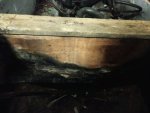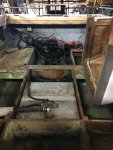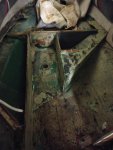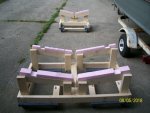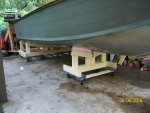Please, talk more! That's what I'm here for!
Anyway, I'm sold on the transom. I'm going to dive in. Looking at it from the inside I can see where the wood is. There are two layers of plywood. One that covers the whole transom, and one that is square and only covers to about 6-8 inches outside of the outdrive. I think I will put two tabs on the outer one, one on the left and one on the right, both extending about 12 inches out at about 8 inches high so that I can mount a kicker on either side.
I do have one major concern with this boat. The front of the keep, where the hook is to trailer the boat, is leaking. There was water in the front of the deck. I don't know yet if it is structural or just a bad seal, but it concerns me as it now indicates that there may be damage to the hull.
Today wasn't a productive day, but I am going to be working diligently tomorrow to remove everything. I have everything out except for the engine, all controls, and the gas tank. So all of the trim, accessories, and cabin parts are removed. Tomorrow I will be guttng the rest and putting the engine on a pallet stand for the winter. I PROMISE I will get some pictures. I'd love to post my process for other first timers to show that it's not too difficult (if I have any luck with it), and I'd also like you guys to see how it's coming. Also, it's been nagging me but the boat is an 89, not an 87. I get this one and my roughmeck confused a lot. Not that it matters, but I want to be accurate.
So, that being said, once the boat is gutted, I've put together a to do list for it. MY BIGGEST QUESTION is if I have to support the hull. Id like to do the boat in sections. Honestly, it's not bad at all. Probably could have gotten a few more years before tearing it apart, but I'm in it now and ready to go. I've read many mixed opinions on supporting the hull and how to replace stringers, but I'd like to do them in sections so that I can keep the old glass shells for each stringer in place until I'm ready to install the new ones, just so I know how exactly they go back in. For construction, I have a few questions:
1. What kind of wood? It's all 1/2"-3/4" plywood, but the only info I can find is "outdoor wood."
2. My general process will be as follows:
a. Remove old stringer/bulkhead
b. Grind residual glass down to the hull
c. Scuff the area up well with 50 grit
d. Measure and cut new stringer/bulkhead
e. Coat new wood with resin/hardener mix a few times until the mixture sits on top of the wood and stops absorbing in.
f. Mix up some pb
g. Make a pb bead on the hull along the length of the stringer
h. Sink stringer into place, leaving 1/4"-1/2" of pb in between the wood and the hull
i. Make a 1/2" fillet along each side of the stringer with the squeezed out pb
j. Apply 3-4 layers of glass to each side, extending each layer 2 inches past the previous.
Is this a good process to follow?
3. What kind of glass mat do you guys recommend?
4. Do I have to let each layer completely cure before adding the next, or can I continue once the layer is tacky?
5. Hull support! Yes or no?
Thank you all and I hope you enjoyed your holiday!




















